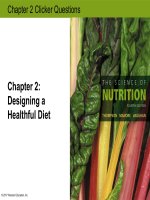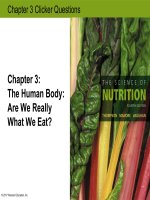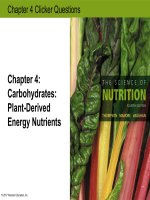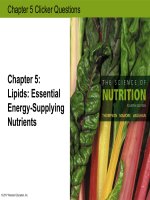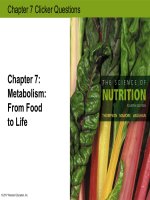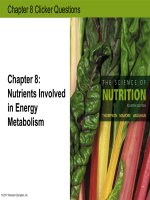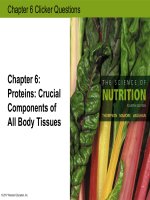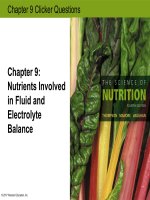Clicker questions the science of NUTRITON 4th by thompson manore and vaughan chapter 10
Bạn đang xem bản rút gọn của tài liệu. Xem và tải ngay bản đầy đủ của tài liệu tại đây (337.41 KB, 21 trang )
Chapter 10 Clicker Questions
Chapter 10:
Nutrients Involved
in Antioxidant
Function and
Vision
© 2017 Pearson Education, Inc.
Oxidation is best described as a process in which
a)
b)
c)
d)
© 2017 Pearson Education, Inc.
a carcinogen causes a mutation in a stem cell's DNA.
an atom loses an electron.
two atoms exchange electrons.
a complex compound is broken apart with the addition of water.
Oxidation is best described as a process in which
a)
b)
c)
d)
© 2017 Pearson Education, Inc.
a carcinogen causes a mutation in a stem cell's DNA.
an atom loses an electron.
two atoms exchange electrons.
a complex compound is broken apart with the addition of water.
Which of the following is a characteristic of vitamin E?
a)
b)
c)
d)
It enhances the absorption of iron.
It can be manufactured from beta-carotene.
It is a critical component of the glutathione peroxidase system.
It protects the lipid molecules in cell
membranes from oxidation.
© 2017 Pearson Education, Inc.
Which of the following is a characteristic of vitamin E?
a)
b)
c)
d)
© 2017 Pearson Education, Inc.
It enhances the absorption of iron.
It can be manufactured from beta-carotene.
It is a critical component of the glutathione peroxidase system.
It protects the lipid molecules in cell membranes from oxidation.
Which of the following is a critical function of vitamin C?
a)
b)
c)
d)
© 2017 Pearson Education, Inc.
It is required for the formation of collagen.
It regenerates glutathione to its antioxidant form.
It reduces the incidence, duration, and severity of the common cold.
It promotes the conversion of beta-carotene to vitamin A.
Which of the following is a critical function of vitamin C?
a)
b)
c)
d)
© 2017 Pearson Education, Inc.
It is required for the formation of collagen.
It regenerates glutathione to its antioxidant form.
It reduces the incidence, duration, and severity of the common cold.
It promotes the conversion of beta-carotene to vitamin A.
Which of the following trace minerals is part of the structure of catalase?
a)
b)
c)
d)
© 2017 Pearson Education, Inc.
iodine
iron
copper
manganese
Which of the following trace minerals is part of the structure of catalase?
a)
b)
c)
d)
© 2017 Pearson Education, Inc.
iodine
iron
copper
manganese
Beta-carotene is
a)
b)
c)
d)
© 2017 Pearson Education, Inc.
a weak antioxidant phytochemical.
a carotenoid.
a provitamin for vitamin A.
all of the above.
Beta-carotene is
a)
b)
c)
d)
© 2017 Pearson Education, Inc.
a weak antioxidant phytochemical.
a carotenoid.
a provitamin for vitamin A.
all of the above.
Vitamin A
a)
participates in the conversion of iodopsin to rhodopsin, a key step in both black-and-white
and color vision.
b)
c)
opposes oxidation of the pigment in rod cells during the bleaching process.
is a key component of the pigment in rod cells
that enables us to perceive black-and-white images.
d)
© 2017 Pearson Education, Inc.
is a key player in the process by which humans see in the dark.
Vitamin A
a)
participates in the conversion of iodopsin to rhodopsin, a key step in both black-and-white
and color vision.
b)
c)
opposes oxidation of the pigment in rod cells during the bleaching process.
is a key component of the pigment in rod cells that enables us to perceive blackand-white images.
d)
© 2017 Pearson Education, Inc.
is a key player in the process by which humans see in the dark.
Deficiency of vitamin A is associated with
a)
b)
c)
d)
© 2017 Pearson Education, Inc.
scurvy and anemia
erythrocyte hemolysis and impaired movement
xerophthalmia and hyperkeratosis
carotenosis and carotenodermia
Deficiency of vitamin A is associated with
a)
b)
c)
d)
© 2017 Pearson Education, Inc.
scurvy and anemia
erythrocyte hemolysis and impaired movement
xerophthalmia and hyperkeratosis
carotenosis and carotenodermia
Within a year or two of its initiation, cancer develops to the point at which it is able to
a)
b)
c)
d)
© 2017 Pearson Education, Inc.
invade surrounding tissues.
establish its own blood supply.
release malignant cells into the blood or lymph.
none of the above is true.
Within a year or two of its initiation, cancer develops to the point at which it is able to
a)
b)
c)
d)
© 2017 Pearson Education, Inc.
invade surrounding tissues.
establish its own blood supply.
release malignant cells into the blood or lymph.
none of the above is true.
The modifiable factor that most significantly increases the risk for cancer is
a)
b)
c)
d)
© 2017 Pearson Education, Inc.
random mutation.
heredity.
tobacco use.
poor nutrition.
The modifiable factor that most significantly increases the risk for cancer is
a)
b)
c)
d)
© 2017 Pearson Education, Inc.
random mutation.
heredity.
tobacco use.
poor nutrition.
A diet rich in antioxidant nutrients may help reduce the risk for CVD by
a)
b)
c)
d)
© 2017 Pearson Education, Inc.
causing body cells with mutated DNA to self-repair or self-destruct.
protecting endothelial cell membranes and reducing inflammation and coagulation.
promoting the synthesis of homocysteine and CRP.
all of the above.
A diet rich in antioxidant nutrients may help reduce the risk for CVD by
a)
b)
causing body cells with mutated DNA to self-repair or self-destruct.
protecting endothelial cell membranes and reducing inflammation and
coagulation.
c)
d)
© 2017 Pearson Education, Inc.
promoting the synthesis of homocysteine and CRP.
all of the above.

